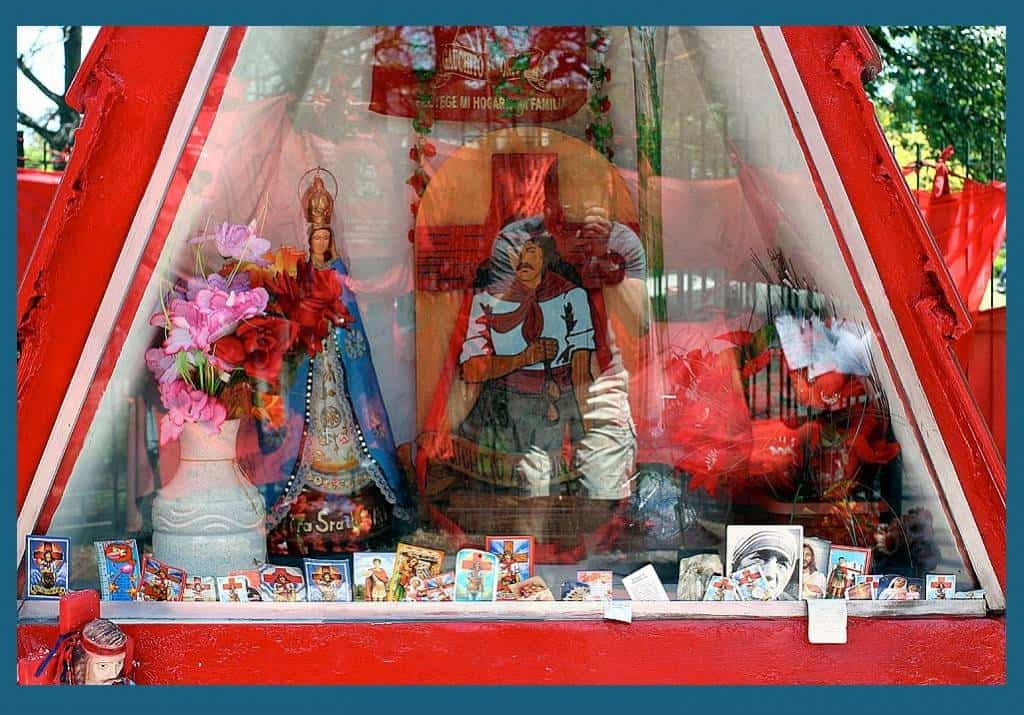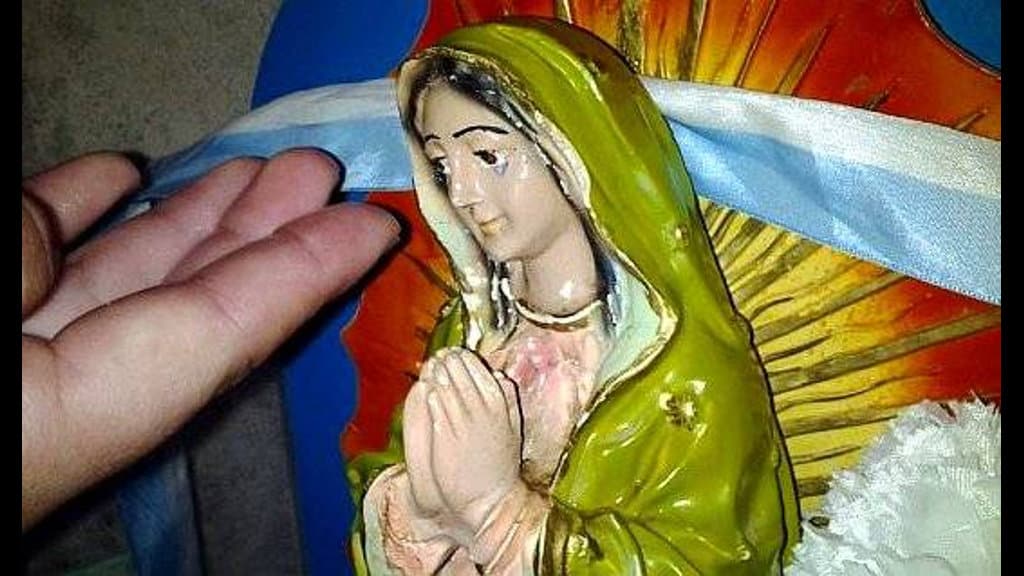The figure of Gauchito Gil, or Antonio Cruz Mamerto Gil Núñez, goes beyond religious boundaries to become a symbol of faith and culture in Argentina. Every January 8th, thousands of faithful gather at the historic sanctuary located at the intersection of routes 119 and 123, near Mercedes, Corrientes, to pay homage to this popular saint whose story and miracles continue to inspire generations.
The Pilgrimage to the Gauchito Gil Sanctuary
Each year, the pilgrimage to the Gauchito Gil Sanctuary becomes a massive event that attracts devotees from all Argentine provinces, as well as neighboring countries like Paraguay, Brazil and Uruguay.
This celebration reflects the deep devotion and popular fervor surrounding the figure of Gauchito Gil, evident in a sea of flags, candles, crosses and red outfits, the color symbolizing the saint and associated with the Autonomist Party of Corrientes, to which Gil belonged during his lifetime.
The city of Mercedes transforms during this time, offering lodging in family homes and equipped campgrounds to accommodate the thousands of pilgrims who arrive, many of them early to participate in the Fiesta del Chamamé, another significant cultural event in the region.
The original cross of the Sanctuary is moved to the Center for Culture and Tourism Interpretation of Mercedes, where it is venerated until January 8th, culminating with a mass in honor of Gauchito Gil at the parish of Our Lady of Mercedes, before starting the pilgrimage to the sanctuary.
This collective expression of faith and tradition not only reinforces the cultural identity of the region but also attracts tourists and curious onlookers, contributing to local development and cultural exchange.
History and Legend of Gauchito Gil
Antonio Cruz Mamerto Gil Núñez, known as Gauchito Gil, was born in 1847 and his life was marked by events that led him to become a legendary figure. After participating in the War of the Triple Alliance, Gil was recruited by the Autonomist Party to fight in the civil war of Corrientes against the Liberal Party.
However, his fate took a drastic turn when he decided to desert, an act that at the time was considered a serious crime.
Captured and sentenced to death, Gil was hung from a tree and killed by a cut to the throat. According to legend, in his final moments, Gil told his executioner, Zalazar, to pray in his name for the life of his son, who was gravely ill.
After carrying out the execution, Zalazar returned home and found his son on the verge of death; however, after praying to Gauchito Gil, his son miraculously recovered.
This first miracle is the core of the devotion surrounding Gauchito Gil and was the catalyst for the construction of a sanctuary in his honor in Mercedes, which remains a place of pilgrimage and veneration today.
The story of Gauchito Gil is a testament to how faith and belief in the miraculous can transform the perception of a historical figure into a popular saint, whose influence transcends time and geographical boundaries.
Miracles and Devotion to Gauchito Gil
Devotion to Gauchito Gil is not limited to an annual event; it is a constant practice that reflects the deep faith of its followers in his miraculous powers. Over the years, numerous testimonies have solidified Gil’s reputation as an intercessor in situations of despair and illness.
Devotees attribute to his intervention the healing of diseases, the resolution of legal problems and protection in times of danger.
The sanctuary in Mercedes is a living testimony of these miracles, where plaques, votive offerings and personal items left by those who claim to have received favors from the saint can be seen.
The relationship between the devotees and Gauchito Gil is intensely personal and emotional. Many relate how their prayers were answered after seeking the intercession of Gauchito, leading to his veneration not only in Corrientes but throughout Argentina and in Argentine communities abroad.
This spiritual bond extends to the Fiesta del Chamamé and other local celebrations, where music and dance merge with religious expression, creating a unique atmosphere where culture and faith intertwine inseparably. This cultural and religious phenomenon underscores the importance of Gauchito Gil as a pillar of the Corrientine and Argentine identity.
The Corrientes Sanctuary: A Place of Gathering and Faith
The Gauchito Gil Sanctuary in Mercedes is more than just a religious site; it serves as a community meeting point and a symbol of Corrientine culture. Situated at the intersection of routes 119 and 123, this place has become a sacred space where pilgrims find comfort, hope and spiritual renewal.
The sanctuary is distinguished by its intense red color, reflecting the color associated with Gauchito Gil and the Autonomist Party. Flags, crosses, candles and red attire fill the space, creating a palpable atmosphere of devotion.
The structure of the sanctuary is adorned with elements that recall the life and legacy of Gauchito Gil, including images, offerings and symbolic elements that narrate his story and miracles.
During the pilgrimage and especially on January 8th, the sanctuary transforms into a vibrant hub of activity. Masses, prayers and songs continue non-stop, as devotees approach to touch the original cross, leave their offerings and ask for intercession.
This place not only attracts the faithful; it is also a tourist attraction that provides a deep insight into the culture and traditions of Corrientes. The impact of the sanctuary extends beyond the spiritual, boosting the local economy through religious and cultural tourism and providing a space for reflection and community gathering.
Fiesta del Chamamé: A Celebration of Faith and Tradition
The Fiesta del Chamamé, held in Mercedes, Corrientes, is another event closely intertwined with the devotion to Gauchito Gil. This festival celebrated the weekend before January 8th, draws tourists and locals alike to enjoy one of Argentina’s most emblematic musical expressions.
Chamamé, with its melancholic melodies and cheerful rhythms, sets the perfect stage to celebrate the life and legacy of Gauchito Gil. Musicians and dancers from all over the region come together to perform shows that reflect the cultural richness of Corrientes.
This event is not only a tribute to Argentine folklore but also serves as a spiritual and festive preparation for the pilgrimage to Gauchito Gil’s sanctuary.
The interplay between the Fiesta del Chamamé and the veneration of Gauchito Gil shows how music and faith can merge to strengthen the cultural and spiritual identity of a community. The music of Chamamé, with its power to move and unite people, becomes a living expression of devotion and love for Gauchito Gil, making this festival a unique event in Argentina’s cultural and religious calendar.
This musical and spiritual gathering not only enriches the experience of the devotees and visitors but also contributes to the recognition and preservation of local traditions, ensuring that the legacy of Gauchito Gil and the Chamamé culture continues to inspire future generations.
The Enduring Legacy of Gauchito Gil
Gauchito Gil is not just a popular saint; he is a cultural icon that encapsulates the essence of devotion, tradition and Argentine identity. His story and the miracles attributed to him have woven a network of faith that connects people of all ages and backgrounds, not only in Corrientes but throughout Argentina and beyond its borders.
The Gauchito Gil Sanctuary in Mercedes and the Fiesta del Chamamé are tangible manifestations of how faith and culture can merge to create events that not only attract devotees and tourists but also revitalize the local economy and strengthen community cohesion. This devotion to Gauchito Gil and the celebration of the Chamamé are living testimonies of a tradition that is renewed year after year, drawing in new generations and keeping the story alive.
The figure of Gauchito Gil remains a source of inspiration and a symbol of hope for many, demonstrating how faith in the miraculous and cultural identity can coexist and enrich each other. His legacy is a reminder of the power of faith to transform lives and communities, ensuring that his story and spirit endure over time.




